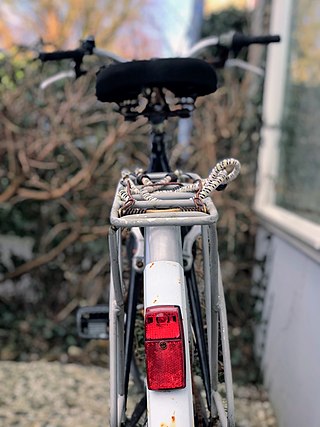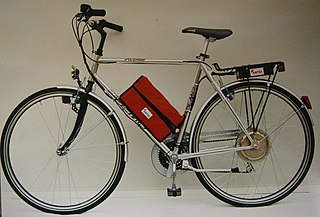
An anti-lock braking system (ABS) is a safety anti-skid braking system used on aircraft and on land vehicles, such as cars, motorcycles, trucks, and buses. ABS operates by preventing the wheels from locking up during braking, thereby maintaining tractive contact with the road surface and allowing the driver to maintain more control over the vehicle.
Twike, based in Rosenthal, is a German manufacturer of light electric vehicles in the European Union vehicle class L5e . The main product, the Twike, is a human-electric hybrid vehicle (HEHV) designed to carry two passengers and cargo. Essentially a velomobile with an electrical hybrid engine, it can be driven in electric-only mode or electric + pedal power mode.

Bicycle lighting is illumination attached to bicycles whose purpose above all is, along with reflectors, to improve the visibility of the bicycle and its rider to other road users under circumstances of poor ambient illumination. A secondary purpose is to illuminate reflective materials such as cat's eyes and traffic signs. A third purpose may be to illuminate the roadway so that the rider can see the way ahead. Serving the latter purposes require much more luminous flux and thus more power.

A cyclocomputer, cycle computer, cycling computer or cyclometer is a device mounted on a bicycle that calculates and displays trip information, similar to the instruments in the dashboard of a car. The computer with display, or head unit, usually is attached to the handlebar for easy viewing. Some GPS watches can also be used as display.
An electronic speed control (ESC) is an electronic circuit that controls and regulates the speed of an electric motor. It may also provide reversing of the motor and dynamic braking. Miniature electronic speed controls are used in electrically powered radio controlled models. Full-size electric vehicles also have systems to control the speed of their drive motors.

A motorized bicycle is a bicycle with an attached motor or engine and transmission used either to power the vehicle unassisted, or to assist with pedalling. Since it sometimes retains both pedals and a discrete connected drive for rider-powered propulsion, the motorized bicycle is in technical terms a true bicycle, albeit a power-assisted one. Typically they are incapable of speeds above 52 km/h (32 mph), however in recent years larger motors have been built, allowing bikes to reach speeds of upwards of 72 km/h.

An electric bicycle is a motorized bicycle with an integrated electric motor used to assist propulsion. Many kinds of e-bikes are available worldwide, but they generally fall into two broad categories: bikes that assist the rider's pedal-power and bikes that add a throttle, integrating moped-style functionality. Both retain the ability to be pedaled by the rider and are therefore not electric motorcycles. E-bikes use rechargeable batteries and typically are motor-powered up to 25 to 32 km/h. High-powered varieties can often travel more than 45 km/h (28 mph).
Many countries have enacted electric vehicle laws to regulate the use of electric bicycles, also termed e-bikes. Some jurisdictions have regulations governing safety requirements and standards of manufacture. The members of the European Union and other regions have wider-ranging legislation covering use and safety.

Brake-by-wire technology in the automotive industry is the ability to control brakes through electronic means, without a mechanical connection that transfers force to the physical braking system from a driver input apparatus such as a pedal or lever.

A dicycle is a vehicle with two parallel wheels, side by side, unlike single-track vehicles such as motorcycles and bicycles, which have two wheels inline. Originally used to refer to devices with large wheels and pedals, the term is now used in relation to powered self-balancing scooters with smaller wheels and no pedals such as the Segway PT and the self-balancing hoverboard.

A Pedelec or EPAC, is a type of low-powered electric bicycle where the rider's pedalling is assisted by a small electric motor. However, unlike some other types of e-bikes, pedelecs are classified as conventional bicycles in many countries by road authorities rather than as a type of electric moped. Pedelecs have an electronic controller that cuts power to the motor when the rider is not pedalling or when a certain speed – usually 25 km/h (16 mph) or 32 km/h (20 mph) – is reached. Pedelecs are useful for people who ride in hilly areas or in strong headwinds. While a pedelec can be any type of bicycle, a pedelec city bike is very common. A conventional bicycle can be converted to a pedelec with the addition of the necessary parts, e.g., motor, battery, etc.

The Kawasaki 1400GTR, also known as the Concours 14 or ZG1400 in some markets, is a sport touring motorcycle produced by Kawasaki. The 1400GTR was introduced in September 2007 and is based on the ZX-14 platform. It replaces the original GTR1000 (Concours), which was built from 1986 to 2006.
The GreenWheel is a modular electronic assist device for bicycles that fits inside the wheel of any standard bicycle and provides additional power above and beyond the power provided by the person pedaling.

A wheelchair is a mobilized form of chair using 2 or more wheels, a footrest and armrest usually cushioned. It is used when walking is difficult or impossible to do due to illnesses, injury, disabilities, or age related health conditions.

Bicycle drivetrain systems are used to transmit power on bicycles, tricycles, quadracycles, unicycles, or other human-powered vehicles from the riders to the drive wheels. Most also include some type of a mechanism to convert speed and torque via gear ratios.
A2B is a brand of electric bicycles owned by Hero Eco Group. They have offices in the United Kingdom and the United States. Established in 2008, A2B designs and manufactures bespoke internal motor systems, and is a pioneering creator of eBikes. Their German design team has crafted a range of 11 electric bike models, each of which is named after a prominent technical innovator, engineer or scientist. Primarily tailored for urban/commuting users, A2B have produced bikes that exude a combination of comfort, picked up speed and stylish design. Their motors range from 250w up to 500w in capacities and there is a choice of pedal assistance or throttle power options. To complement the collection, A2B develops custom accessories including carriers and bags.
Superpedestrian Inc., was a transportation robotics company based in Cambridge, Massachusetts, that developed electrified and AI technologies for micro mobility vehicles. The company ran the LINK e-scooter sharing program, which was active in 57 cities across the US and Europe.

The BMW i4 is a battery electric compact executive car produced by BMW since 2021. It adopts a five-door liftback body style and is marketed as a four-door coupé. The initial concept version, named BMW i Vision Dynamics, debuted at the 2017 Frankfurt Motor Show. It is the fifth BMW i sub-brand model, and is sold in several variants at different performance levels, including the first battery-electric variant by BMW's motorsport division. The production version was revealed in March 2021 and went on sale in November of the same year as a 2022 model.












